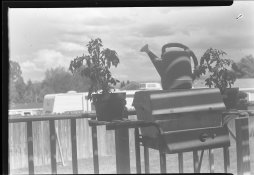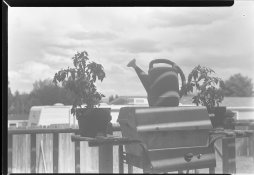Pioneer
Member
I am putting this under Medium Format Cameras and Accessories because the three specific cameras I am referring to in this thread are using 2.25x3.25 inch sheet film which are considered medium format but I also use several of these same types of camera that use 4x5 large format film.
Lately I have been clearing out some of the many cameras that I currently own so I have been opening up some old and dusty boxes on my shelves. In one of these boxes were three Graflex 6x9 cameras. One is a Speed Graphic and the other two are Graflex RB Series B cameras. Now, as I said, I do own a Graflex RB and a few Crown Graphics in 4x5 that I use from time to time, but I haven't used these three cameras for quite some time, maybe since I picked them up years ago.
One thing I like to do before I get ready to sell anything is check things out and determine what works and what doesn't. If it doesn't work, why not and will it be easy to fix. If it does work then how well. Are there problems like slow shutters, light leaks, etc. that may have to be resolved if you wanted to use them. Most of the time with these older cameras, particularly if I haven't used them in a long time if I even used them at that time.
So, I pulled these cameras out and did some preliminary testing. They all look a bit rough around the edges with scuffs and dings. Surprise! The shutters all seemed to work and sounded to be somewhat close to what they needed to be for a decent exposure. The lenses weren't bad and the bellows did not leak any light. So I dug around some more and found some film holders for the cameras.
I am not sure how old these cameras are but both Graflex Series B cameras have Graflex backs. That would indicate that they were built sometime before World War II. They were nice cameras in their day because they have rotating backs but the film accessories are harder to find. Irregardless I decided to try them out so I loaded some sheet film into one of the Grafmatic Film Holders, went outside and shot 6 shots. In the process I accidentally exposed one sheet to the sun when I removed the film holder without checking that that sheet had been returned into the film holder.
The conclusion to this particular story, which is already far too long, is that all five of the sheets that were normally exposed turned out fine. Yep, you heard right. We are talking about a pre-war Graflex that has not been touched in a number of years and, as far as I am aware, has not been taken apart and serviced in quite a long time. The shutter cloth looks old and fragile so I seriously doubt that they have been changed, maybe since these cameras were new. Yet everything turned out great.
Now I am certainly not an expert on these cameras but just how amazing is it that this very, very old camera basically focused and exposed the film perfectly. Then, just to take things another step, I tested the second Graflex today and the film came out great. So now I am two for two with the Speed Graphic to be tested last, probably tomorrow.
To me this is an amazing result for cameras that were definitely put together well before I was born. I fiddle around with old cameras all the time and I cannot remember when I film tested one where there wasn't some problem that had to be corrected. Yet these worked perfectly the first time out. I am impressed. Needless to say I think I will hold onto these for awhile as they are amazingly nice to use.
Lately I have been clearing out some of the many cameras that I currently own so I have been opening up some old and dusty boxes on my shelves. In one of these boxes were three Graflex 6x9 cameras. One is a Speed Graphic and the other two are Graflex RB Series B cameras. Now, as I said, I do own a Graflex RB and a few Crown Graphics in 4x5 that I use from time to time, but I haven't used these three cameras for quite some time, maybe since I picked them up years ago.
One thing I like to do before I get ready to sell anything is check things out and determine what works and what doesn't. If it doesn't work, why not and will it be easy to fix. If it does work then how well. Are there problems like slow shutters, light leaks, etc. that may have to be resolved if you wanted to use them. Most of the time with these older cameras, particularly if I haven't used them in a long time if I even used them at that time.
So, I pulled these cameras out and did some preliminary testing. They all look a bit rough around the edges with scuffs and dings. Surprise! The shutters all seemed to work and sounded to be somewhat close to what they needed to be for a decent exposure. The lenses weren't bad and the bellows did not leak any light. So I dug around some more and found some film holders for the cameras.
I am not sure how old these cameras are but both Graflex Series B cameras have Graflex backs. That would indicate that they were built sometime before World War II. They were nice cameras in their day because they have rotating backs but the film accessories are harder to find. Irregardless I decided to try them out so I loaded some sheet film into one of the Grafmatic Film Holders, went outside and shot 6 shots. In the process I accidentally exposed one sheet to the sun when I removed the film holder without checking that that sheet had been returned into the film holder.
The conclusion to this particular story, which is already far too long, is that all five of the sheets that were normally exposed turned out fine. Yep, you heard right. We are talking about a pre-war Graflex that has not been touched in a number of years and, as far as I am aware, has not been taken apart and serviced in quite a long time. The shutter cloth looks old and fragile so I seriously doubt that they have been changed, maybe since these cameras were new. Yet everything turned out great.
Now I am certainly not an expert on these cameras but just how amazing is it that this very, very old camera basically focused and exposed the film perfectly. Then, just to take things another step, I tested the second Graflex today and the film came out great. So now I am two for two with the Speed Graphic to be tested last, probably tomorrow.
To me this is an amazing result for cameras that were definitely put together well before I was born. I fiddle around with old cameras all the time and I cannot remember when I film tested one where there wasn't some problem that had to be corrected. Yet these worked perfectly the first time out. I am impressed. Needless to say I think I will hold onto these for awhile as they are amazingly nice to use.



 . I got it from this camera collector seller who used to have one of those 2 page ad spreads in "shutterbug magazine". These old graflex slr's a prefectly weighted and a dream to use. I hope you enjoy using yours for as long as you don't need the money from selling it
. I got it from this camera collector seller who used to have one of those 2 page ad spreads in "shutterbug magazine". These old graflex slr's a prefectly weighted and a dream to use. I hope you enjoy using yours for as long as you don't need the money from selling it 

